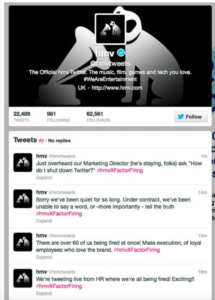This year we have read a lot about restructures and redundancies, with Dyson, E.On and House of Fraser the latest household names making the headlines over the last week. Generally, redundancy has a negative sentiment for the entire spectrum of people impacted. For executives, the decision to restructure is a result of shareholder pressure, competitive forces, consumer trends, escalating costs or a change in ownership/leadership. Or any combination of these. For HR and legal, an inevitable redundancy programme means a very busy period doing not particularly nice work. For employees however, redundancy is often life changing – for better and worse. Redundancy effectively leads to employee re-cycling as those impacted will continue to function in society and the workplace in a different role.
A redundancy programme – large or small – is an organisational reputation risk factor, and will typically be in any crisis communications plan. When considering the risks, there are several stakeholder groups to evaluate the impact on an organisations’ reputation. These include, but are not limited to, investors, customers, suppliers, key influencers/industry commentators/media and the local community. Most importantly, the one stakeholder group an organisation must pay special attention to, for obvious reasons, is employees – both those impacted and those that remain.
Employees really are an organisations’ biggest brand ambassadors. When you turn the tables, it can be disasterous if not handled correctly. The internet is full of instances, for example HMV’s redundancy programme announced by administrators in January 2013.

These employees were quick to show their love for HMV, but their actions were damaging to this solid consumer brand. Many have learnt from HMV and social media policies and passwords are better managed. There is however always a reputation risk when communicating redundancies. Employees will likely vent their feelings verbally and digitally. Again, plenty instances on the internet. The company review site Glassdoor is a rich source of employee and ex-employee watercooler talk, with all negative experiences documented for the world to read. Some posts read like a jilted lover.
So why should organisations planning or delivering redundancy programmes pay so much attention to their reputation in the face of far greater business challenges. Or even survival, as in the case of HMV? The reasons is that every time a brand is mentioned by a current or ex-employee in a conversation, a social media post or a news article, it is an opportunity to reinforce what is good about that brand. When there is a negative sentiment associated with the brand, such as redundancy, it is potentially damaging if not handled sensitively and correctly with a number of potential consequences:
- Retention. Supporting employees and maintaining morale during turbulent times is critical to maintaining business continuity, productivity and retaining employees.
- Recruitment of new employees. Love or loathe it, Glassdoor is the ‘go to’ place to research a company ahead of a job application, interview or acceptance of a job offer. There are also many different professional forums where gossip is exchanged – the best know is the Professional Pilots Rumour Network.
- Shareholder confidence. Shareholders dislike reports of strained internal relationships and unhappy employees. They dislike even more bad press and social media posts from disgruntled ex-employees.
- Customer confidence. Customers dislike bad press associated with brand they love and trust. They also don’t like to see a company operating contrary to their stated values.
- Supplier and partner relationships. Carillion, a UK construction giant that collapsed earlier this year, is the best example of this as we read numerous reports of supplier and contractors not being paid, and consequential job losses.

When sending out employees for recycling in the job market, thinking beyond legal and HR obligations, and the outplacement programmes is key. Poorly handled redundancy programmes with the ugly inner workings of a company will be revealed somewhere in conversations and on the internet, and the internet is forever. The importance of fully understanding the value of current and ex-employee as brand ambassadors cannot be emphasised enough. Good organisations will want to hear that those employees they are letting go would happily re-join the company in the future.
Internal and external reputation management is critical when delivering clear, relevant, timely and sensitive communications to all impacted stakeholders during a restructure and redundancy programme. If this is ignored or glossed over, it leaves the door wide open to more potential business challenges beyond sending out P45’s.
More reading on this topic:
The ACAS redundancy handling guide for employers.
Personnel Today article detailing a checklist of actions that can help mitigate reputation risks during redundancy programme. This reinforces the need to have a completely integrate approach towards managing internal and external communications during a redundancy programme.
An interesting Harvard Business Review article looking at the wider long term cost of redundancy programmes using Michelin and Nokia as case studies. It concludes " ... companies tend to prioritize short-term financial results over the long-term well-being of their employees, employees are the lifeblood that enables a company to keep delivering the products and services that ultimately generate shareholder benefits."

